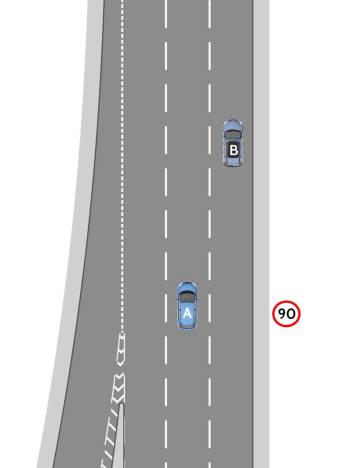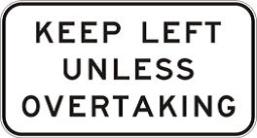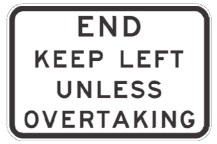This is the next blog in the series on misunderstood road rules. If reading comments on the various motoring organisations’ Facebook posts is anything to go by, this is seriously misunderstood by a great many people.
Firstly, a question; in this image which vehicle or vehicles are breaking the law. There are no other vehicles within 1km of this scene and no further intersections.

.
.
.
.
If you answered A and B, I’m afraid you were wrong. The correct answer is B only.
One of the common misconceptions about this law, quite possibly arising from the wording on the road signs, is that you must be driving in the left lane unless you are overtaking. This would apply only if there were just two lanes; where there are three or more lanes this rule applies only to the very far right lane.
Another common misconception is that this rule applies to every multilane road. This rule only applies if the speed limit of the road is over 80km/h; note that the rules specify over 80, this means that this law does not apply to roads where the speed limit is 80km/h, unless that stretch of road has a “Keep Left Unless Overtaking” sign applying to it (more of this later).
The rule concerning keep left unless overtaking is contained in the Australian Road Rules at rule 130.
130—Keeping to the left on a multi-lane road
- This rule applies to a driver driving on a multi-lane road if—
(a) the speed limit applying to the driver for the length of road where the driver is driving is over 80 kilometres per hour; or
(b) a keep left unless overtaking sign applies to the length of road where the driver is
Note 1—
Length of road and multi-lane road are defined in the dictionary.
Note 2—
Part 3 deals with speed limits.
2. The driver must not drive in the right lane unless—
(a) the driver is turning right, or making a U-turn from the centre of the road, and is giving a right change of direction signal; or
(b) the driver is overtaking; or
(c) a left lane must turn left sign or left traffic lane arrows apply to any other lane and the driver is not turning left; or
(d) the driver is required to drive in the right lane under rule 159; or
(e) the driver is avoiding an obstruction; or
(f) the traffic in each other lane is congested; or
(g) the traffic in every lane is congested; or
(h) the right lane is a special purpose lane in which the driver, under another provision of the Australian Road Rules, is permitted to drive; or
(i) there are only 2 marked lanes and the left lane is a slow vehicle turn out lane.
Offence provision.
Note 1—
Centre of the road, left traffic lane arrows, obstruction, overtake, right change of direction signal, special purpose lane, traffic and U-turn are defined in the dictionary.
Note 2—
Rule 159 deals with traffic signs that require a particular kind of vehicle to drive in the marked lane indicated by the signs.
Note 3—
Rule 329 deals with when a traffic control device applies to a marked lane.
3. A keep left unless overtaking sign on a multi-lane road applies to the length of road beginning at the sign and ending at the nearest of the following:
(a) an end keep left unless overtaking sign on the road;
(b) a traffic sign or road marking on the road that indicates that the road is no longer a multi-lane road;
(c) if the road ends at a T-intersection or dead end—the end of the road.
Note—
Road marking, T-intersection and traffic sign are defined in the dictionary.
(4) In this rule—
- lane, for a driver, means a marked lane for vehicles travelling in the same direction as the driver, but does not include a special purpose lane in which the driver is not permitted to drive.
Note 1—
Marked lane and special purpose lane are defined in the dictionary.
Note 2—
Rule 95 deals with driving in emergency stopping lanes, and Division 6 of this Part deals with driving in other special purpose lanes.
- slow vehicle turn out lane means a marked lane, or the part of a marked lane, to which a slow vehicle turn out lane sign applies.
Note—
A slow vehicle turn out lane is designed for slow-moving vehicles to move into to allow faster vehicles to pass in an adjacent marked lane.
Discussion of rule 130.
Sub rule 1 covers the situations where this rule applies which we have already covered at the beginning of this article.
Sub rule 2, specifies that the rule applies to the right hand lane, which again has already been discussed in this article, and also lists the instances when you are allowed to drive in the right lane. We will examine these a bit more closely.
a) This allows for the driver to be in the right lane if they are turning right or performing a U-turn. The rules do not govern how long before your right turn you may be in the right lane; however it does specify that you must be displaying a right turn signal, so it would be unreasonable to be in the lane 5 km before your turn but not unreasonable to be in the right lane with your right signal on 500m before your turn.
b) When overtaking obviously speaks for itself. Remember though that you need to preserve crash avoidance space, both before and when returning to your original lane.
c) Signs or road markings indicate that the left lane must turn left and you aren’t wanting to turn left again, obviously, speaks for itself.
d) To comply with rule 159:
159—Marked lanes required to be used by particular kinds of vehicles.
e) Avoiding an obstruction. Again this speaks for itself. Obstruction is defined in the dictionary to the road rules as follows:
obstruction includes a traffic hazard, but does not include a vehicle only because the vehicle is stopped in traffic or is travelling more slowly than other vehicles.
f) The traffic in each other lane is congested. Again this speaks for itself.
g) The traffic in all lanes is congested. Similar to f but including the far right lane.
h) The right lane is a special purpose lane in which you are permitted to drive under another rule of the Australian Road Rules. Special purpose lane is defined in the dictionary as follows:
special purpose lane means a marked lane, or the part of a marked lane, that is a bicycle lane, bus lane, emergency stopping lane, tram lane, transit lane or truck lane.
i) If there are only two lanes, and the left lane is a slow vehicle turnout lane. Sub rule 4 defines a slow vehicle turnout lane.
Sub rule 3 explains the extent of road this rule applies to.
On a road where this rule applies by virtue of the signage, as opposed to the speed limit, the rule applies to the whole length of the road until:
- an End keep left sign,
- until the road is no longer a multi-lane road or
- until the end of the road.


Further Confusion?
Another rule that might be worth mentioning in passing, which I think contributes to the confusion of some people concerning this rule is Rule 129.
Rule 129 concerns un-laned roads only, therefore has no bearing on this topic whatsoever.
129—Keeping to the far left side of a road
(1) A driver on a road (except a multi-lane road) must drive as near as practicable to the far left side of the road.
Offence provision.
Note—
Multi-lane road is defined in the dictionary.
(2) This rule does not apply to the rider of a motor bike.
Note—
Motor bike is defined in the dictionary.
(3) In this rule—
road does not include a road-related area.
Note—
Road-related area includes the shoulder of a road—see rule 13.
